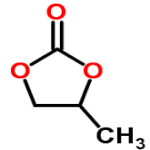Propylene Carbonate USP NF Grade & Propylene Glycol BP Ph Eur USP FCC Food Grade Suppliers Exporters, Manufacturers
Propylene Carbonate
CAS Number: 108-32-7, USP NF Grade Suppliers Exporters, Manufacturers
Please visit Safety Data Sheet of Propylene Carbonate Manufacturers.
Specifications of Propylene Carbonate USP NF Grade
4-Methyl-1,3-dioxolan-2-one.
Cyclic propylene carbonate CAS 108-32-7
Propylene Carbonate contains not less than 99.0 percent and not more than 100.5 percent of C4H6O3.
Identification: Infrared Absorption.
Specific gravity: between 1.203 and 1.210 at 20C.
pH: Gently but thoroughly mix 10 mL with 0.3 mL of saturated potassium chloride solution in a 100-mL borosilicate volumetric flask. Dilute with carbon dioxide-free water having a pH of 7.0 ± 0.5 to volume. Completely purge the solution by vigorous nitrogen bubbling, and continue the bubbling during the pH measurement. Determine the pH potentiometrically when the reading stabilizes: it is between 6.0 and 7.5.
Residue on ignition: not more than 0.01%.

Please visit Hazard Statement of Propylene Carbonate Suppliers.
Propylene Glycol
CAS Number: 57-55-6 or 25322-69-4, BP Ph Eur USP FCC Food Grade Suppliers Exporters, Manufacturers
Please visit Safety Data Sheet of Propylene Glycol Manufacturers.
Specifications of Propylene Glycol BP Ph Eur Grade
Ph Eur C3H8O2 -- 76.1 -- CAS 57-55-6
Action and use: Excipient.
DEFINITION
Propylene glycol is (RS)-propane-1,2-diol.
CHARACTERS
A viscous, clear, colourless, hygroscopic liquid, miscible with water and with ethanol (96 per cent).
IDENTIFICATION
A. It complies with the test for relative density.
B. It complies with the test for refractive index.
C. Boiling point: 184C to 189C.
D. To 0.5 ml add 5 ml of pyridine and 2 g of finely ground nitrobenzoyl chloride. Boil for 1 min and pour into 15 ml of cold water with shaking. Filter, wash the precipitate with 20 ml of a saturated solution of sodium hydrogen carbonate and then with water and dry. Dissolve in boiling ethanol (80 per cent V/V) and filter the hot solution. On cooling, crystals are formed which, after drying at 100C-105C, melt at 121;C to 128C.
TESTS
Appearance: It is clear and colourless.
Relative density: 1.035 to 1.040.
Refractive index: 1.431 to 1.433.
Acidity: To 10 ml add 40 ml of water R and 0.1 ml of bromothymol blue solution. The solution is greenish-yellow. Not more than 0.05 ml of 0.1 M sodium hydroxide is required to change the colour of the indicator to blue.
Oxidising substances: To 10 ml add 5 ml of water, 2 ml of potassium iodide solution and 2 ml of dilute sulphuric acid and allow to stand in a ground-glass-stoppered flask protected from light for 15 min. Titrate with 0.05 M sodium thiosulphate, using 1 ml of starch solution as indicator. Not more than 0.2 ml of 0.05 M sodium thiosulphate is required.
Reducing substances: To 1 ml add 1 ml of dilute ammonia and heat in a water-bath at 60C for 5 min. The solution is not yellow. Immediately add 0.15 ml of 0.1 M silver nitrate and allow to stand for 5 min. The solution does not change its appearance.
Heavy metals: 5 ppm m/V.
Water: Not more than 0.2 per cent, determined on 5.00 g by the semi-micro determination of water.
Sulphated ash: Heat 50 g until it burns and ignite. Allow to cool. Moisten the residue with sulphuric acid and ignite; repeat the operations. The residue weighs not more than 5 mg (0.01 per cent).
Specifications of Propylene Glycol USP Grade
C3H8O2 76.09
1,2-Propanediol.
1,2-Propanediol CAS 57-55-6
Propylene Glycol contains not less than 99.5 percent of C3H8O2.
Identification: Infrared Absorption 1on undried specimen.
Specific gravity: between 1.035 and 1.037.
Acidity: Add 1 mL of phph to 50 mL of water, then add 0.1 N sodium hydroxide until the solution remains pink for 30 seconds. Then add 10 mL of Propylene Glycol, accurately measured, and titrate with 0.10 N sodium hydroxide until the original pink color returns and remains for 30 seconds: not more than 0.20 mL of 0.10 N sodium hydroxide is required.
Water: not more than 0.2%.
Residue on ignition: Heat 50 g in a tared 100-mL shallow dish until it ignites, and allow it to burn without further application of heat in a place free from drafts. Cool, moisten the residue with 0.5 mL of sulfuric acid, and ignite to constant weight: the weight of the residue does not exceed 3.5 mg.
Chloride: A 1-mL portion shows no more chloride than corresponds to 0.10 mL of 0.020 N hydrochloric acid (0.007%).
Sulfate: A 5.0-mL portion shows no more sulfate than corresponds to 0.30 mL of 0.020 N sulfuric acid (0.006%).
Heavy metals: Mix 4.0 mL with water to make 25 mL: the limit is 5 ppm.
Specifications of Polypropylene Glycol FCC Food Grade
CAS 25322-69-4
DESCRIPTION
Polypropylene Glycol occurs as a clear, colorless or practically colorless, viscous liquid. It is an addition polymer of propylene glycol and water represented by the formula HO(C3H6O)n- C3H6OH, in which n represents the average number of oxypropylene groups. It is soluble in water and in such organic solvents as aliphatic ketones and alcohols, but it is insoluble in ether and in most aliphatic hydrocarbons.
Function: Defoaming agent.
REQUIREMENTS
Lead:Not more than 1 mg/kg.
Nominal Molecular Weight: Not less than 90.0% and not more than 110.0% of the labeled value.
pH: Between 6.0 and 9.0.
Propylene Oxide: Not more than 0.02%.
Residue on Ignition: Not more than 0.01%.
Viscosity: Passes test.

Please visit Hazard Statement of Propylene Glycol Manufacturers.
Propylene Carbonate USP NF Grade CAS Number 108-32-7 & Propylene Glycol BP Ph Eur USP FCC Food Grade CAS Number 57-55-6 or 25322-69-4 Supplier Exporter, Manufacturer:
Annie Chemie P Ltd
Mumbai 4000010, INDIA
With Agents and offices in UAE, USA, Europe.
e-mail: info@anniechemie.com
Copyright and Usual Disclaimer is Applicable.
June 1, 2025
Exporters to USA, Canada, UK, Europe, UAE, Nigeria, Algeria, Turkey, Mexico, Brazil, Chile, Argentina, Australia, Dubai etc.
Perfection is made up of small things and that is a big thing.
